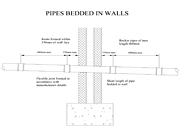and Detail Drawings
Wales
England
- Offices
- Shops / Commercial
- Industrial Buildings
- Storage / Assembly Buildings
- Other Non-Residential
Drainage - Foul Water
Foul Water Drainage
Foul water comprises of ‘black’ soil water from toilets and ‘grey’ waste water from baths, basins, sinks, washing machines etc.
A foul water drainage system carries foul water from the building to an underground sewer pipe, a cesspool, a septic tank or a wastewater treatment system. (Public sewers are not considered in this guidance and consultation with the Local water authority should be sought when building near or over a public sewer – see below.)
The Building Regulations 2010 require that the foul water should be discharged ‘in order of priority’, therefore where it is reasonably practicable to do so, a connection should be made:

Add To Basket
Includes DXF,
DWG & JPG
- 1) to a public sewer.
- 2) to a private sewer communicating with a public sewer.
- 3) to a septic tank or other wastewater treatment plant.
- 4) to a cesspool.
The first solution on the list should preferably be adopted. Where this is not possible, move down the list to the next.
Combined and Separate systems of drainage
Underground drainage systems can be divided into two types :
- 1) Combined system - In a combined system, the foul water and the rainwater are carried in the same underground pipes. The advantages of this system are, firstly, that the rainwater helps to clean the pipework minimising blockages, and secondly less pipe work is required, although the pipe sizes may need to be increased.
- 2) Separate system - In a separate drainage system, separate sewer pipes are provided for the foul water and the rainwater.
The water authorities discourage combined systems because:
- 1) They can cause an overload of the drainage system.
- 2) They produce an increased amount of water to treat. New developments are often required to provide a separate system of drainage up to the point of connection with a combined sewer.
Pipe materials
In the past, drainage pipes have been made from a variety of materials, including pitch fibre, vitrified clay, uPVC, concrete, glassfibre reinforced plastics (GRP), iron and asbestos cement.
Not all of the materials used have performed well, for example, pitch fibre has a tendency to collapse under heavy clay soils and expensive repair work may be required.
Today, most new domestic drainage is constructed using plastic (flexible) pipes or clay (rigid) pipes, usually 100mm and 110mm in diameter, or 150mm and 225mm in diameter for public sewer pipes.
Types of pipes
- Socketed clayware.
- Plain-end clay c/w coupling.
- Plastic 100/150mm.

Add To Basket
Includes DXF,
DWG & JPG
Clay
Clay drainage pipes date back to the Victorian times. Their inherent strength means they are more durable and less likely to deform under loads than plastic. They are also:
- Highly frost resistant.
- Rodent resistant.
- Able to be laid directly into a well trimmed trench (Class D bedding).
Clay pipe manufacturers promote their environmental advantages, claiming clay uses less energy in production as well as requiring less aggregates for bedding and backfilling.
Plastic
Typically golden brown in colour, 110mm plastic pipes are the most common material used for underground drainage today.
The advantage of plastic pipework is that it is:
- Relatively cheap compared to clay.
- Frost resistant.
- Simple to cut to size with a hacksaw and lightweight, making the pipes easy to handle and work with.
- Flexible and can remain watertight and resist fracture when subject to small amounts of movement.
However, excessive pressure from loads or ground movement may cause plastic pipes to deform. Therefore they must be surrounded by a good bedding material such as pea-shingle, to provide support and prevent the pipe from cracking.
BuildingRegs4Plans Building Regulations Specifications
BuildingRegs4Plans Web Apps save Architects, Designers and Surveyors hours! Our 5 web apps provide precompiled Building Regs Specifications that can be compiled into a custom specification for your Building Projects.
Checkout our Building Regs Specifications Web Apps here:
Drainage - Foul Water
Foul Water Drainage
Foul water comprises of ‘black’ soil water from toilets and ‘grey’ waste water from baths, basins, sinks, washing machines etc.
A foul water drainage system carries foul water from the building to an underground sewer pipe, a cesspool, a septic tank or a wastewater treatment system. (Public sewers are not considered in this guidance and consultation with the Local water authority should be sought when building near or over a public sewer – see below.)
The Building Regulations 2010 require that the foul water should be discharged ‘in order of priority’, therefore where it is reasonably practicable to do so, a connection should be made:

Add To Basket
Includes
DWG and Jpeg
- 1) to a public sewer.
- 2) to a private sewer communicating with a public sewer.
- 3) to a septic tank or other wastewater treatment plant.
- 4) to a cesspool.
The first solution on the list should preferably be adopted. Where this is not possible move down the list to the next.
Combined and Separate systems of drainage
Underground drainage systems can be divided into two types :
- 1) Combined system - In a combined system the foul water and the rainwater are carried in the same underground pipes. The advantages of this system are firstly, that the rainwater helps to clean the pipework minimising blockages, and secondly, less pipe work is required, although the pipe sizes may need to be increased.
- 2) Separate system - In a separate drainage system, separate sewer pipes are provided for the foul water and the rainwater.
The water authorities discourage combined systems because:
- 1) They can cause an overload of the drainage system.
- 2) They produce an increased amount of water to treat. New developments are often required to provide a separate system of drainage up to the point of connection with a combined sewer.
Pipe materials
In the past, drainage pipes have been made from a variety of materials, including pitch fibre, vitrified clay, uPVC, concrete, glassfibre reinforced plastics (GRP), iron and asbestos cement.
Not all of the materials used have performed well, for example, pitch fibre has a tendency to collapse under heavy clay soils and expensive repair work may be required.
Today, most new domestic drainage is constructed using plastic (flexible) pipes or clay (rigid) pipes, usually 100mm and 110mm in diameter, or 150mm and 225mm in diameter for public sewer pipes.
Types of pipes
- Socketed clayware.
- Plain-end clay c/w coupling.
- Plastic 100/150mm.

Add To Basket
Includes
DWG and Jpeg
Clay
Clay drainage pipes date back to the Victorian times. Their inherent strength means they are more durable and less likely to deform under loads than plastic. They are also:
- Highly frost resistant.
- Rodent resistant.
- Able to be laid directly into a well trimmed trench (Class D bedding).
Clay pipe manufacturers promote their environmental advantages, claiming clay uses less energy in production as well as requiring less aggregates for bedding and backfilling.
Plastic
Typically golden brown in colour, 110mm plastic pipes are the most common material used for underground drainage today.
The advantage of plastic pipework is that it is:
- Relatively cheap compared to clay.
- Frost resistant.
- Simple to cut to size with a hacksaw and lightweight, making the pipes easy to handle and work with.
- Flexible and can remain watertight and resist fracture when subject to small amounts of movement.
However, excessive pressure from loads or ground movement may cause plastic pipes to deform. Therefore they must be surrounded by a good bedding material such as pea-shingle, to provide support and prevent the pipe from cracking.
BuildingRegs4Plans Building Regulations Specifications
BuildingRegs4Plans Web Apps save Architects, Designers and Surveyors hours! Our 5 web apps provide precompiled Building Regs Specifications that can be compiled into a custom specification for your Building Projects.
Checkout our Building Regs Specifications Web Apps here:
To begin compiling your Building Regulations Specification with one of our Web-Apps, choose either House Extension, New Build, Flat Conversion, Loft Conversion, Garage Conversion, Basement Conversion, Flat Conversion, New Build Flats or Garage Build.






















